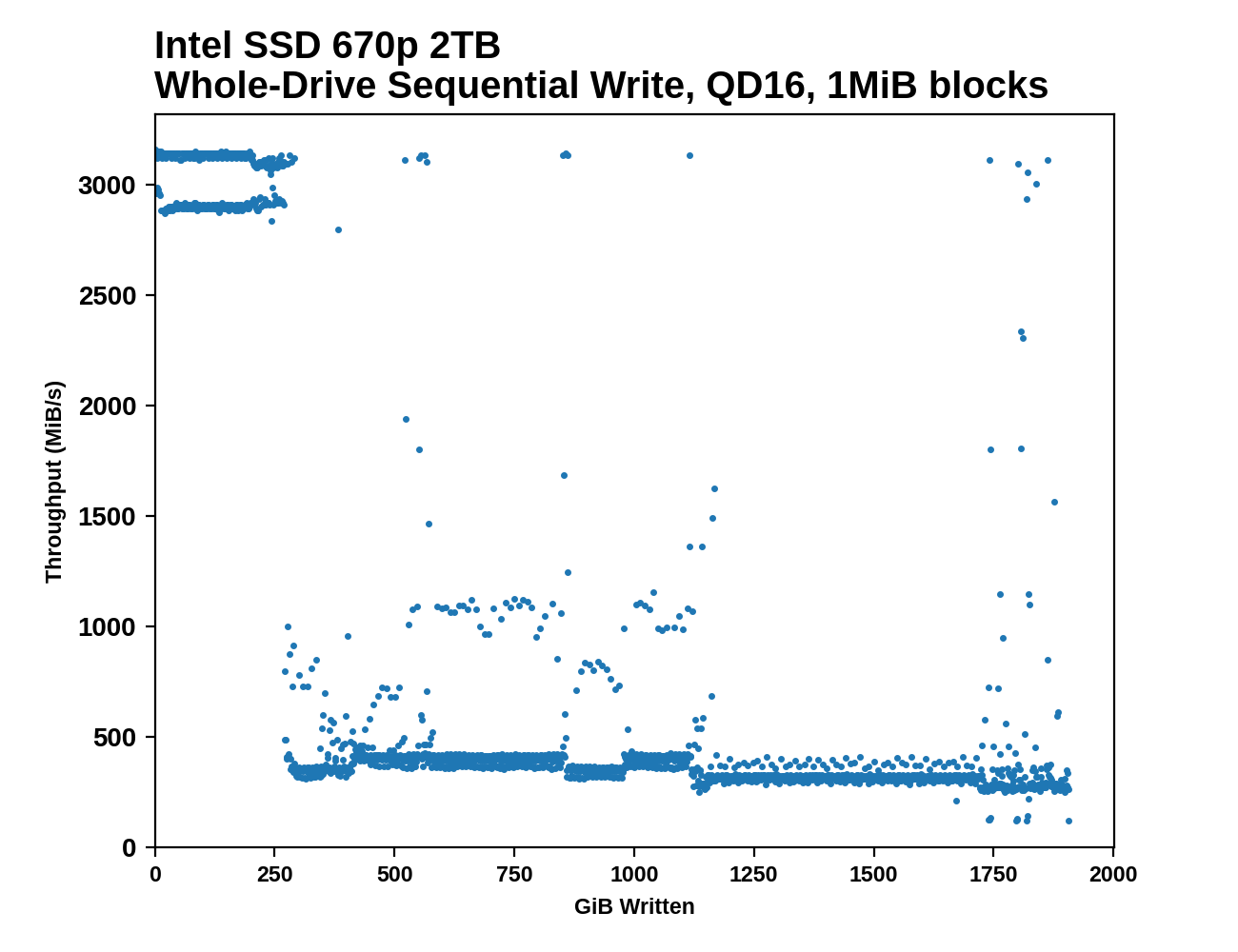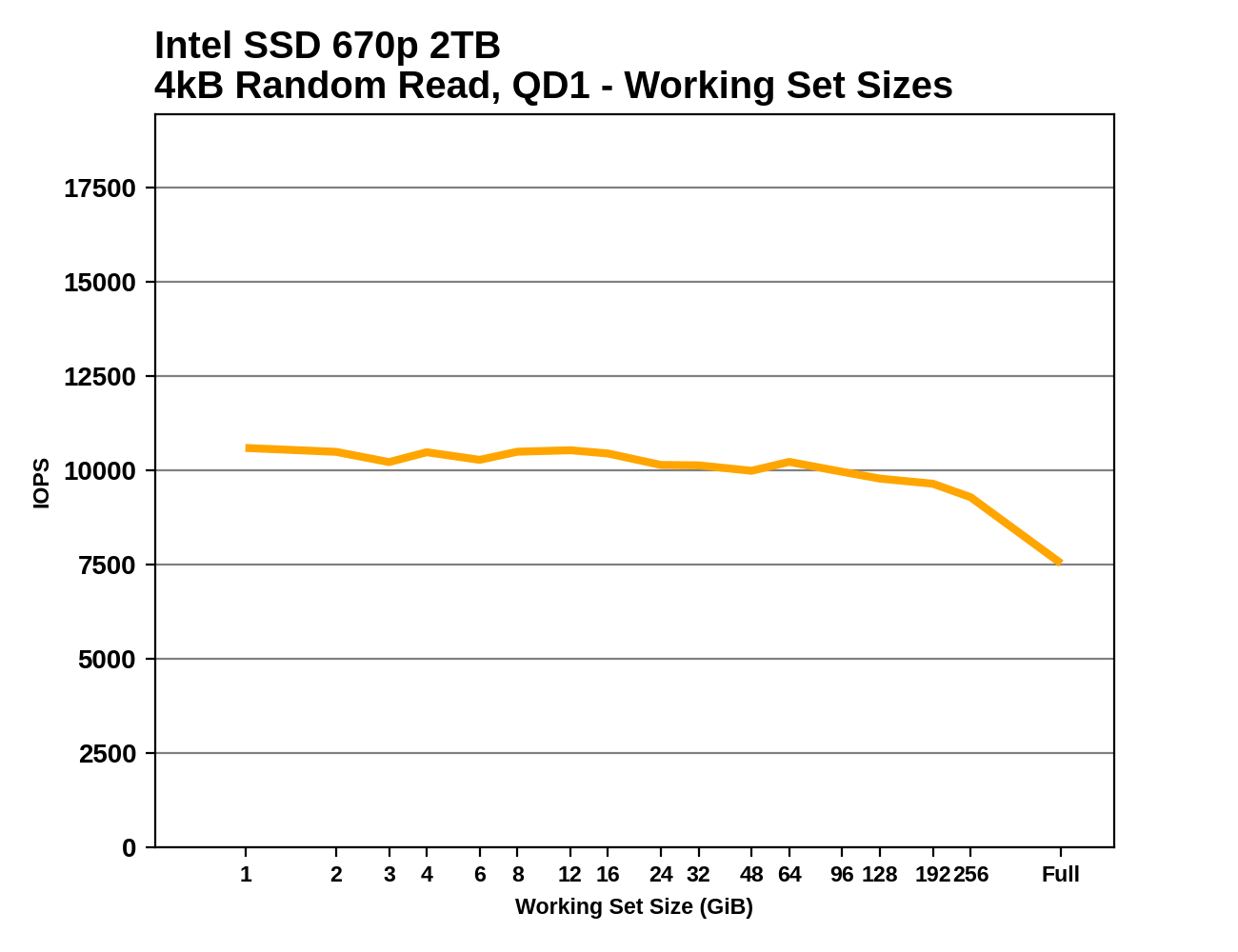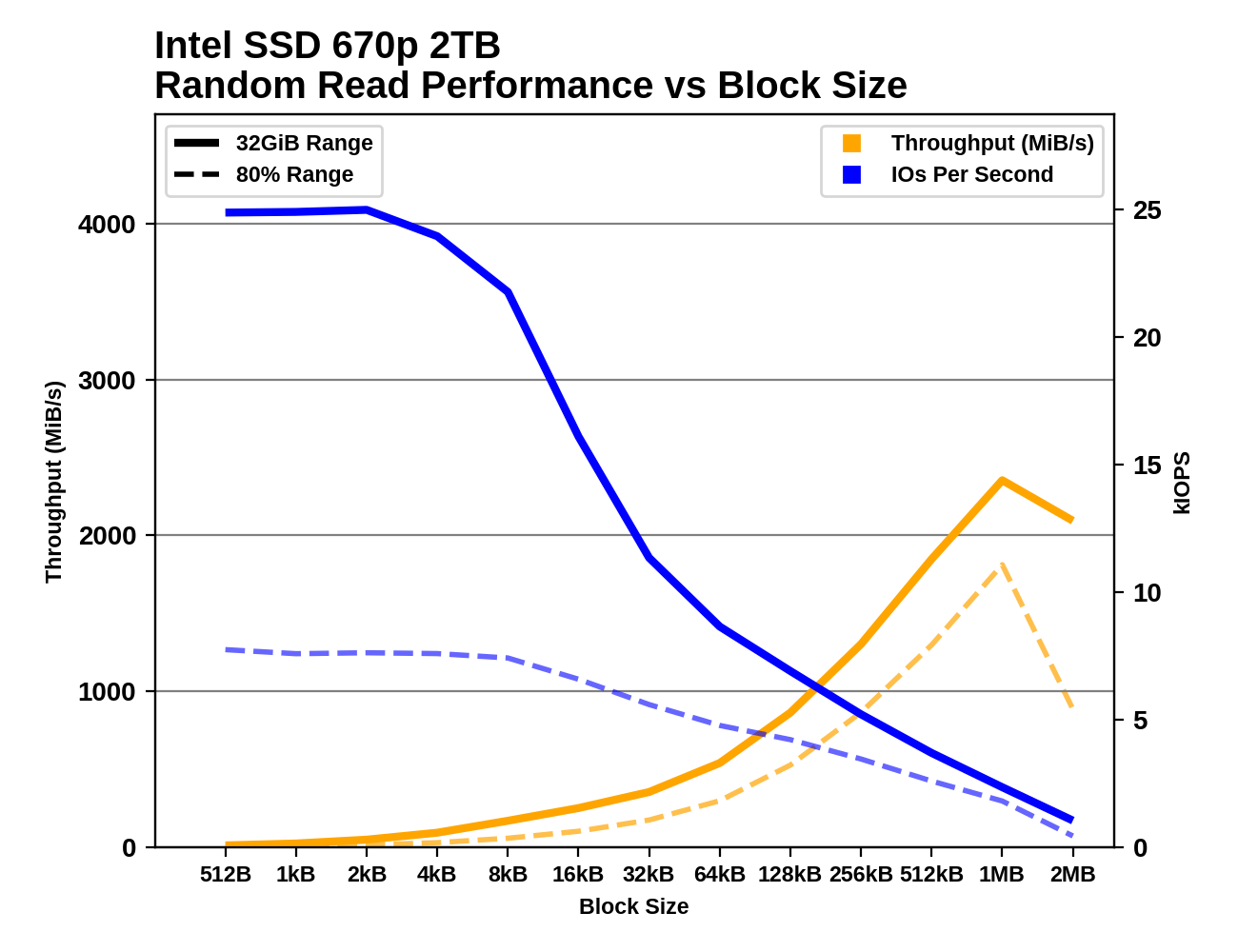The Intel SSD 670p (2TB) Review: Improving QLC, But Crazy Pricing?!?
by Billy Tallis on March 1, 2021 12:00 PM ESTAdvanced Synthetic Tests
Our benchmark suite includes a variety of tests that are less about replicating any real-world IO patterns, and more about exposing the inner workings of a drive with narrowly-focused tests. Many of these tests will show exaggerated differences between drives, and for the most part that should not be taken as a sign that one drive will be drastically faster for real-world usage. These tests are about satisfying curiosity, and are not good measures of overall drive performance. For more details, please see the overview of our 2021 Consumer SSD Benchmark Suite.
Whole-Drive Fill
 |
|||||||||
| Pass 1 | |||||||||
| Pass 2 | |||||||||
The Intel SSD 670p shows less consistent performance than the 660p during the sequential drive write. Writing to the SLC cache bounces between two performance levels, just above and just below 3 GB/s. The cache runs out more or less on schedule and performance drops down into SATA territory with sporadic outliers that are faster than normal. There's a bit of a stepped downward trend in performance as the drive approaches full. On the second pass that overwrites data on a full drive, the 670p is even more inconsistent with short bursts up to SLC write speed throughout the process.
 |
|||||||||
| Average Throughput for last 16 GB | Overall Average Throughput | ||||||||
The overall average write speed of the 670p is now almost enough to saturate a SATA interface. At the tail end of the filling process it does dip down to hard drive speeds, but any large sequential transfer of data onto the 670p will definitely complete more quickly than any one hard drive can handle. The controller upgrade helps some here (primarily with the SLC cache write speed), but for the most part the NAND itself is still the bottleneck, which means the smaller capacities of the 670p will not perform as well.
Working Set Size
 |
|||||||||
Intel is still clearly using a reduced DRAM design with the 670p rather than the full 1GB per 1TB ratio that mainstream SSDs use. The drop in performance at large working set sizes closely mirrors what we saw with the 660p, albeit with higher performance across the board thanks to the lower latency of the 144L NAND.
Performance vs Block Size
 |
|||||||||
| Random Read | |||||||||
| Random Write | |||||||||
| Sequential Read | |||||||||
| Sequential Write | |||||||||
With the 670p, Intel has eliminated the IOPS penalty that random reads smaller than 4kB suffer on the 660p, but that effect is still present for random writes. The IOPS difference between the short-range tests that hit the SLC cache and the 80% full drive tests is bigger for the 670p than the 660p; the newer drive has generally improved performance, but is in some ways even more reliant on the SLC cache.
Sequential throughput on the 670p keeps increasing with larger block sizes, long past the point where the 660p saturated its controller's limits. The performance trends for both sequential reads and writes are well-behaved with little disparity between the short-range tests and the 80% full drive tests, and no indication of the SLC cache running out during the sequential write tests.










72 Comments
View All Comments
superjim - Monday, March 1, 2021 - link
The 1TB 665p has been going for $80-90 since last November. The increased performance of the 670 is nowhere near the relative price increase even with the current chip shortages. SSD prices have stagnated for nearly 2 years now. I bought a 2TB Sabrent Rocket for $220 back in July of 2019.XacTactX - Monday, March 1, 2021 - link
I agree with you, and the way I see it, QLC is supposed to be 2x denser than TLC, so manufacturers should be able to offer a significant discount for a QLC drive instead of a TLC drive. When Intel is selling the 665p for $80-90 it is reasonable for a person to buy QLC, but for $150 it's kinda crazy. At $150 I would recommend the Phison E12 or Samsung 970 Evo / Evo Plus, they have more consistent performance and higher write endurance than the 670p.cyrusfox - Monday, March 1, 2021 - link
They are going 3 bits per cell to 4 bits per cell. That is not double the density but only 1/3 denser.That said I would expect them to be priced competitively as the 660p are priced. I feel like the 665P were on cleareance and I also picked up a 1TB model for $90.
Eventually they will be priced retail to whatever the market will bear I guess. I was able to pick up a lot of optane 16GB drives for $8-10 recently. I remember when they launched at $40 new...
XacTactX - Monday, March 1, 2021 - link
Thanks for the information, this whole time I was under the impression that MLC has 4 bits per cell, TLC has 8 bits, and QLC has 16 bits. I thought the number of phases per cell is the same as bits per cell. It turns out that MLC is 2 bpc, TLC is 3 bpc, and QLC is 4 bpc. I've been reading about SSDs since 2010, only took me 11 years to figure it out :PYeah I want to try Intel Optane as well, I noticed that the 16 GB version is super cheap, I think it's because OEMs were buying them and now they are liquidating their supply. I want the 32 GB version but the pricing is too expensive, I can't justify $70 for a 32 GB Optane drive
Zizy - Monday, March 1, 2021 - link
Nah, SLC needs to distinguish 2 voltage levels for 1 bit, MLC needs to distinguish 4 voltage levels to read those 2 bits, TLC needs to distinguish 8 for 3 bits etc. Density improvements are going up at a slow pace, while complexity doubles every next step. That's why every next step took longer before it made sense and became successful on the market. We are still at TLC->QLC transition and it seems it will take a while longer before we are close to done. Especially if such overpriced QLC products get launched - you can get a pretty good TLC for the money.kpb321 - Monday, March 1, 2021 - link
Time will tell but so far QLC hasn't really provided a benefit in most cases for consumers except at possibly the largest size. If you remember back to the planar TLC it was not very popular and didn't work too well either. Going to the 3d flash manufacturing and subsequently going back to much larger lithography as part of that process is what really made TLC usable and popular. I don't see a similar transition coming to help out QLC so we will have to see if it can slowly improve enough to make it worth while for the typical consumer.ichaya - Tuesday, March 2, 2021 - link
The 960EVO did pretty well for TLC and PCIE3, and a QLC drive that can do PCIE4 speeds would do as well IMO. This endurance is about where the 960EVO was... 370TBW vs 400TBW for 1TB. Just get those speeds up, and it would easily be worth the asking price or more. Maybe in another generation or I hope not two.ksec - Monday, March 1, 2021 - link
Yes. I dont mind QLC or even OLC. I want cheaper, and larger SSD.meacupla - Monday, March 1, 2021 - link
So Intel's CPUs are a dudThen their SSDs turned into dud
If intel somehow screws up their network and wifi chips, that will be something to see.
Slash3 - Tuesday, March 2, 2021 - link
*cough*https://www.pugetsystems.com/labs/support-hardware...